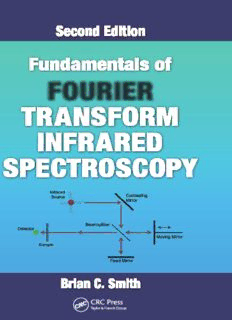Table Of ContentSecond Edition
Fundamentals of
FOURIER
TRANSFORM
INFRARED
SPECTROSCOPY
Second Edition
Fundamentals of
FOURIER
TRANSFORM
INFRARED
SPECTROSCOPY
Brian C. Smith
Boca Raton London New York
CRC Press is an imprint of the
Taylor & Francis Group, an informa business
CRC Press
Taylor & Francis Group
6000 Broken Sound Parkway NW, Suite 300
Boca Raton, FL 33487-2742
© 2011 by Taylor and Francis Group, LLC
CRC Press is an imprint of Taylor & Francis Group, an Informa business
No claim to original U.S. Government works
Printed in the United States of America on acid-free paper
10 9 8 7 6 5 4 3 2 1
International Standard Book Number-13: 978-1-4200-6930-3 (Ebook-PDF)
This book contains information obtained from authentic and highly regarded sources. Reasonable efforts
have been made to publish reliable data and information, but the author and publisher cannot assume
responsibility for the validity of all materials or the consequences of their use. The authors and publishers
have attempted to trace the copyright holders of all material reproduced in this publication and apologize to
copyright holders if permission to publish in this form has not been obtained. If any copyright material has
not been acknowledged please write and let us know so we may rectify in any future reprint.
Except as permitted under U.S. Copyright Law, no part of this book may be reprinted, reproduced, transmit-
ted, or utilized in any form by any electronic, mechanical, or other means, now known or hereafter invented,
including photocopying, microfilming, and recording, or in any information storage or retrieval system,
without written permission from the publishers.
For permission to photocopy or use material electronically from this work, please access www.copyright.
com (http://www.copyright.com/) or contact the Copyright Clearance Center, Inc. (CCC), 222 Rosewood
Drive, Danvers, MA 01923, 978-750-8400. CCC is a not-for-profit organization that provides licenses and
registration for a variety of users. For organizations that have been granted a photocopy license by the CCC,
a separate system of payment has been arranged.
Trademark Notice: Product or corporate names may be trademarks or registered trademarks, and are used
only for identification and explanation without intent to infringe.
Visit the Taylor & Francis Web site at
http://www.taylorandfrancis.com
and the CRC Press Web site at
http://www.crcpress.com
To my loving and lovely wife, Marian.
© 2011 by Taylor & Francis Group, LLC
Contents
Preface.......................................................................................................................xi
Acknowledgments ..................................................................................................xiii
Chapter 1 Introduction to Infrared Spectroscopy .................................................1
I. Terms and Definitions ...............................................................1
II. The Properties of Light .............................................................2
III. What Is an Infrared Spectrum? .................................................5
IV. What Are Infrared Spectra Used For? ......................................8
V. The Advantages and Disadvantages of Infrared
Spectroscopy .............................................................................8
VI. The Advantages and Disadvantages of FTIR ..........................12
A. The Advantages of FTIRs .................................................12
B. The Disadvantage of FTIR ................................................16
VII. FTIR: The Rest of the Story ....................................................16
References ..........................................................................................17
Chapter 2 How an FTIR Works ..........................................................................19
I. Interferometers and Interferograms ........................................19
A. How Many Scans Should Be Used? ..................................28
II. How an Interferogram Becomes a Spectrum ..........................30
A. Scanning Advice ................................................................34
III. Instrumental Resolution ..........................................................36
A. What Determines Resolution in an FTIR Scan? ...............37
B. What Resolution Should Be Used? ....................................39
IV. FTIR Trading Rules ................................................................40
V. FTIR Hardware .......................................................................41
A. Interferometers ..................................................................41
B. Infrared Sources ................................................................42
C. Beamsplitters .....................................................................43
D. Infrared Detectors .............................................................44
E. The Laser ...........................................................................47
VI. Testing Instrument Quality and Troubleshooting ....................49
References ..........................................................................................53
Chapter 3 Proper Use of Spectral Processing .....................................................55
I. The Rules of Spectral Processing ............................................55
II. Spectral Subtraction ................................................................56
A. Subtraction Artifacts .........................................................60
III. Baseline Correction .................................................................62
vii
© 2011 by Taylor & Francis Group, LLC
viii Contents
IV. Smoothing ...............................................................................66
V. Spectral Derivatives.................................................................69
VI. Deconvolution ..........................................................................72
A. Guidance, Precautions, and Limitations ...........................74
VII. Spectral Library Searching .....................................................76
A. The Search Process ...........................................................78
B. Interpreting Library Search Results ..................................81
VIII. Analysis of Mixtures: Subtract and Search Again ..................83
References ..........................................................................................85
Chapter 4 Preparing Samples Properly ...............................................................87
I. Transmission Sampling Overview ...........................................87
A. Windows, Cells, and Materials for Transmission
Analysis ..............................................................................89
II. Transmission Analysis of Solids and Powders ..............................90
A. KBr Pellets .........................................................................90
1. Mechanical Grinding ....................................................92
2. Advantages and Disadvantages of KBr Pellets .............93
B. Mulls ..................................................................................94
1. The Split Mull Method .................................................96
III. Transmission Analysis of Polymers ......................................100
A. The Cast Film Method .....................................................100
B. The Heat and Pressure Method .......................................102
IV. Transmission Analysis of Liquids .........................................106
A. Capillary Thin Films .......................................................106
B. Sealed Liquid Cells..........................................................109
V. Transmission Analysis of Gases and Vapors .........................113
VI. Reflectance Analysis .............................................................119
A. Different Types of Reflectance ........................................119
B. Advantages and Disadvantages of Reflectance
Sampling ..........................................................................121
VII. Specular Reflectance .............................................................122
VIII. Diffuse Reflectance (DRIFTS) .............................................124
A. Abrasive Sampling...........................................................127
IX. Attenuated Total Reflectance (ATR) .....................................129
A. Depth of Penetration ........................................................131
X. Applications of ATR ..............................................................138
A. Liquids .............................................................................138
B. Semi-Solids ......................................................................139
C. Polymers ..........................................................................140
D. Powders ............................................................................141
XI. ATR: Advantages and Disadvantages ...................................144
XII. FTIR Sample Preparation: Overview
and Recommendations ..........................................................145
References ........................................................................................146
© 2011 by Taylor & Francis Group, LLC
Contents ix
Chapter 5 Quantitative Infrared Spectroscopy .................................................147
I. Terms and Definitions ...........................................................147
II. Beer’s Law .............................................................................148
III. Calibration and Prediction with Beer’s Law .........................150
A. Calibration .......................................................................150
B. Prediction .........................................................................152
C. An Experimental Protocol for Single Component
Analyses ...........................................................................153
1. Analyzing for a Single Analyte ...................................153
IV. Measuring Absorbances Properly .........................................154
A. Peak Areas versus Peak Heights .....................................154
B. Dealing with Overlapped Peaks ......................................156
V. Avoiding Experimental Errors ..............................................157
References ........................................................................................159
Chapter 6 Infrared Microscopy.........................................................................161
I. Hyphenated Infrared Techniques ..........................................161
II. Infrared Microscopy Instrumentation ...................................161
III. Sample Preparation ................................................................165
IV. Applications ...........................................................................170
V. Infrared Mapping and Imaging .............................................171
References ........................................................................................174
Glossary ................................................................................................................175
© 2011 by Taylor & Francis Group, LLC
Description:Reflecting the myriad changes and advancements in the technologies involved in FTIR, particularly the development of diamond ATRs, this second edition of Fundamentals of Fourier Transform Infrared Spectroscopy has been extensively rewritten and expanded to include new topics and figures as well as u

